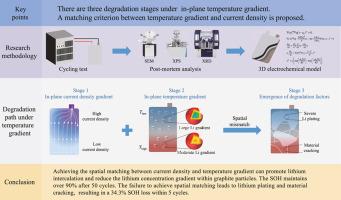Degradation mechanism of lithium-ion battery under appropriate in-plane temperature gradient
IF 16.4
引用次数: 0
Abstract
Temperature significantly affects battery performance. However, the mechanism of in-plane temperature gradient caused by high current on battery degradation is still unclear. In this study, the in-plane temperature gradient is artificially constructed between battery tabs and bottom region. Then, the fast-charging cycling test is performed. Post-mortem analysis after battery cycling is carried out to obtain the anode surface morphology and elemental distribution. A three-dimensional electrochemical model is developed to obtain the internal parameter distributions during fast charging. The results indicate that the battery degradation process can be divided into three stages: in-plane current density gradient stage, in-plane temperature gradient stage, and emergence of degradation factors stage. A spatial matching criterion between in-plane temperature gradient and in-plane current density gradient is proposed to suppress battery degradation, where optimal performance is achieved when high current density region coincide with high temperature region. Specifically, the in-plane temperature gradient with high temperature at the high current density tabs and low temperature at the low current density bottom region enhances battery fast charging performance, maintaining over 90% capacity after 50 cycles at 2C charging rate. However, an in-plane temperature gradient in the opposite direction can lead to lithium plating and material cracking, with a 34.3% capacity loss after just 5 cycles. Additionally, the low-temperature discharge tests demonstrate that achieving the spatial matching criterion can enhance battery discharge performance. Specifically, the discharge capacity increases by 8% at −20 °C. This study provides a novel temperature-regulation-based approach for reducing battery polarization.

适当面内温度梯度下锂离子电池的降解机理
温度对电池性能影响很大。然而,大电流引起的面内温度梯度对电池退化的机理尚不清楚。在本研究中,在电池片和底部区域之间人为地构建了面内温度梯度。然后进行快充循环测试。对电池循环后的阳极表面形貌和元素分布进行了分析。建立了三维电化学模型,得到了快速充电过程中的内部参数分布。结果表明,电池降解过程可分为三个阶段:面内电流密度梯度阶段、面内温度梯度阶段和降解因素的产生阶段。为了抑制电池退化,提出了面内温度梯度与面内电流密度梯度的空间匹配准则,当高电流密度区域与高温区域重合时,电池性能达到最佳。其中,高电流密度区域温度高,低电流密度底部温度低的面内温度梯度增强了电池的快速充电性能,在2C充电速率下,50次循环后容量保持在90%以上。然而,相反方向的面内温度梯度会导致镀锂和材料开裂,仅5次循环后容量损失34.3%。低温放电试验表明,满足空间匹配准则可以提高电池的放电性能。具体来说,在−20℃时,放电容量增加8%。该研究为降低电池极化提供了一种基于温度调节的新方法。
本文章由计算机程序翻译,如有差异,请以英文原文为准。
求助全文
约1分钟内获得全文
求助全文

 求助内容:
求助内容: 应助结果提醒方式:
应助结果提醒方式:


